The cruel reality of creating FPS for mobile devices
The creation of FPS games ( first person shooter ) for mobile devices has always been a “hard nut”. Despite the many attempts of developers with varying degrees of success, the most ardent fans are still waiting for the true candidate.
Traditionally, FPS games required players to be highly skilled, accurate, fast, focused and skillful. That is what made the sensations of playing on the learning curve so pleasant (or annoying, depending on how much the player mastered it).
Before learning how to recreate the gameplay of computer or console FPS on mobile devices, let's consider what kind of load usually affects the player.
For a casual observer, FPS may look like indiscriminate and meaningless shooting:
')

But do not be deceived; in fact, a FPS player juggles with a multitude of cognitive loads of various sizes, coordinates motor and sensory skills, and fights against the interference created by control devices in order to achieve his goal.
Does this statement seem surprising to you?

As a juggler who balances several loads, usually while playing FPS, the player must balance the following cognitive loads :
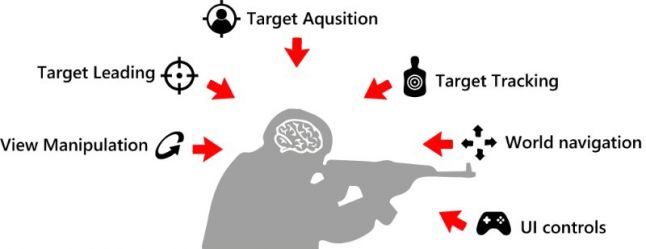
Target Capture: A player must effectively capture moving or static targets in order to accomplish a kill.
Keeping the goal: the player must effectively “lead” the goal. For example, if the opponent moves to the right of the player, then the player must create his mental copy for a successful hit.
Goal tracking: you need to track moving targets so that you do not need to constantly retake them. For example, if the enemy moves to the right, the player must constantly smoothly follow the enemy, without losing sight of him.
Camera control: the player moves the camera in the right directions for tracking, tracking and capturing targets. The difference in the speed with which a player can control the field of view affects the ability to track and drive fast moving targets.
Moving around the world: the player must be able to move along the X, Y and Z axes of the game world in order to overcome obstacles or jump onto objects.
UI control: along with the above tasks, the player is required to control the UI control for equipment, applying character abilities, turning on sight, using boosts, shooting control, reloading and changing weapons.
Game controllers transmit these tasks to the UI, which reduces the load by providing a better display. But this does not apply to the standard gameplay on mobile devices.
Interesting study
Because of the above loads, the learning curve for mastering FPS is very steep; sensory interaction and lack of usable space on mobile devices make it even worse.
Fitts Act:

This scientific law predicts that the time required for a quick move to the target area is a function of the ratio of the distance to the target and the width of the target.
The farther the target is and the smaller its size, the more difficult it is for the user to “catch” this target.
This implies that the smaller the moving target, the more difficult it is for players in FPS to aim and shoot at it. Studies conducted in a controlled environment have shown that mouse pointers are more accurate in capturing long-range small targets:
Comparison of the aiming area of a finger and mouse.

The middle area that can be selected with the mouse and finger:
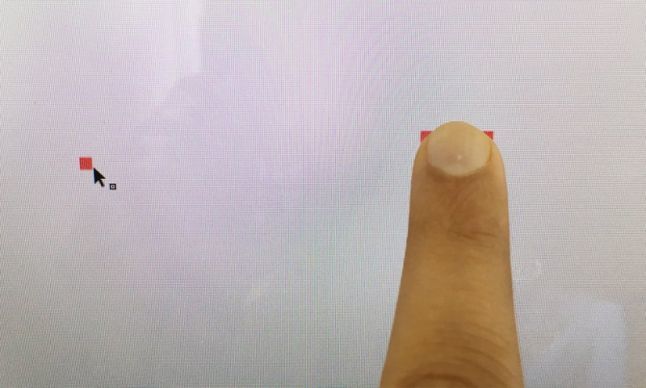
The images above show the pixel-by-pixel movement (pixel-perfect control) of the mouse pointer, resulting in a smaller aiming area as compared to a less accurate (minimum 40 pixels) aiming area with your finger.

Finger overlapping the aiming area is also a well-known problem.
Error rate measurements for various input devices:

Give up, the mouse pointers won in accuracy and capture of small and distant targets, mainly due to the ability to quickly jump to the right pixel on the screen.
So, on mobile devices, the lack of usable space and touch input has become a real problem. Add to this the various loads and movements (discussed above) that a player must manage in hardcore FPS and lack of accuracy of the input device (finger), which makes adaptation even more difficult.
However, the question is how to solve these problems, being a developer of mobile games?
Let's find out:

The main thing is load management!
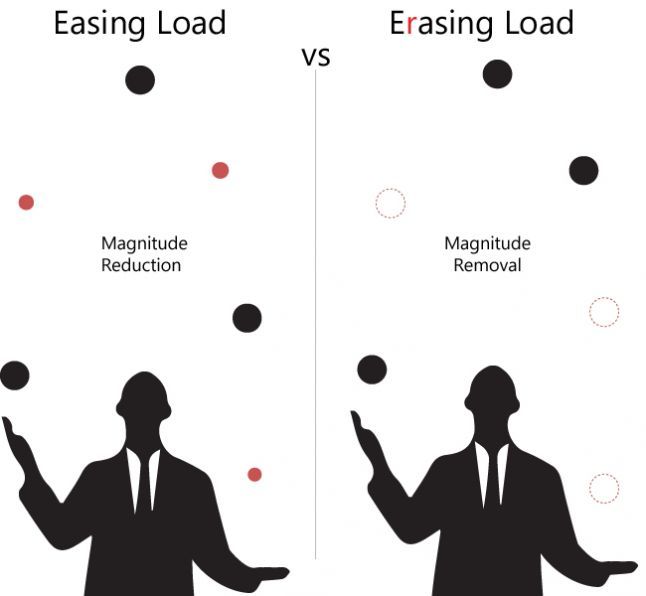
Reduced loads: reduced values; removal of loads: getting rid of quantities
Many successful mobile FPS-games tried to adapt the gameplay, concentrating on facilitating load management , reducing them by reducing the values or eliminating them, completely getting rid of them. Below I will provide examples of such solutions.
Despite the difficulties listed above, some game developers have tried to recreate the key FPS gameplay on mobile devices; The most notable and successful of these was the Gameloft series Modern Combat.
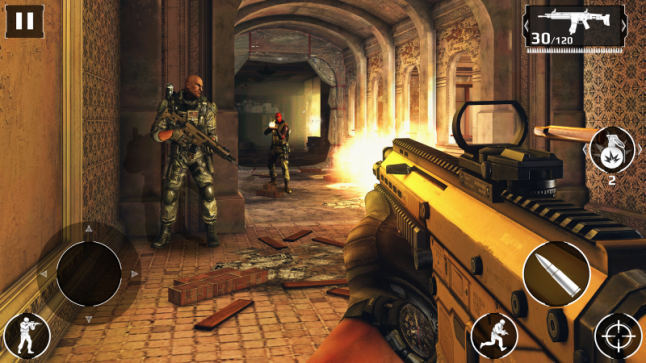
The Modern Combat series has become the most popular among FPS players on mobile devices. The latest version of MC-5 (an MC-6 release is expected soon) has become evidence of a multitude of iterations performed by GL to fine-tune how users perceive the game.
At first, the MC-5 provides players with standard control options, but soon there is ample room for flexible, personalized settings.
Before launching a mission on the settings screen, players in the MC-5 can choose one of three different control options:

Below are three standard control schemes with 13 parameters , with a wide range of configuration options. They significantly reduce the magnitude of the various loads on the player:

The following explains how these options reduce the magnitude of the various loads described above.
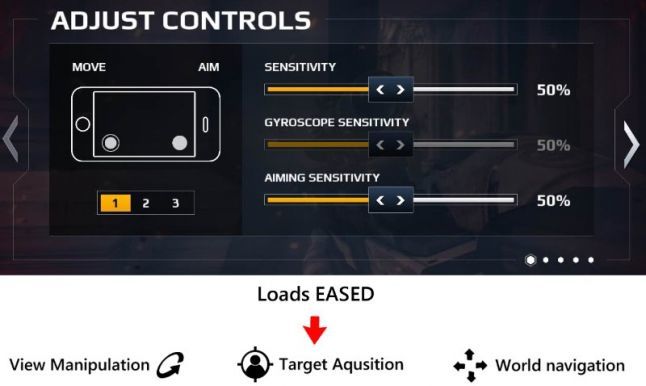
Settings for screen sensitivity, gyroscope sensitivity and aiming sensitivity reduce camera control loads, target acquisition and movement around the world
The lack of accuracy caused by the lack of a mouse on a small screen is compensated by adjusting the sensitivity of the sensor and the built-in gyroscope, which helps the player to use the device as a controller.

Assistance in aiming, automatic shooting and squatting (these settings are included only in a single game) reduce the load of controlling the camera, tracking a target, capturing a target and moving around the world
Assistance in aiming and automatic shooting reduces the difficulty of tracking and capturing targets, allowing the player to focus on other game loads and reducing dependence on UI controls; The same is true for automatic squats.

Automatic running, camera re-centering and smooth camera movement reduce camera control loads, movement around the world and target tracking
One of the most powerful pain points on mobile devices is the small size of the map due to the very nature of the scene and the limited view of the camera; This leads to the fact that the player can fall victim to the enemies who track him, especially on multiplayer maps; The above settings significantly reduce the load.
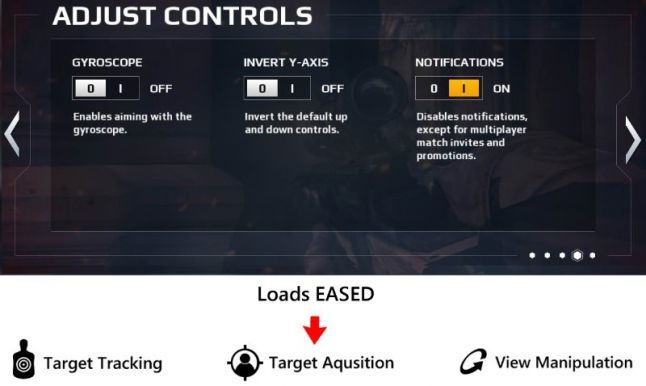
Aiming with a gyroscope, the ability to invert the vertical axis and turn off pop-up notifications reduce the load of tracking the target, leading the target and controlling the camera
Three standard control schemes with 13 settings. If you think it is a little too, hold on - there are others. So far we have considered only the control settings before the mission, but in the MC-5 there are other settings options that can be changed during the mission on the pause screen .

This second level of highly detailed HUD setup is only available on the pause screen during game play.
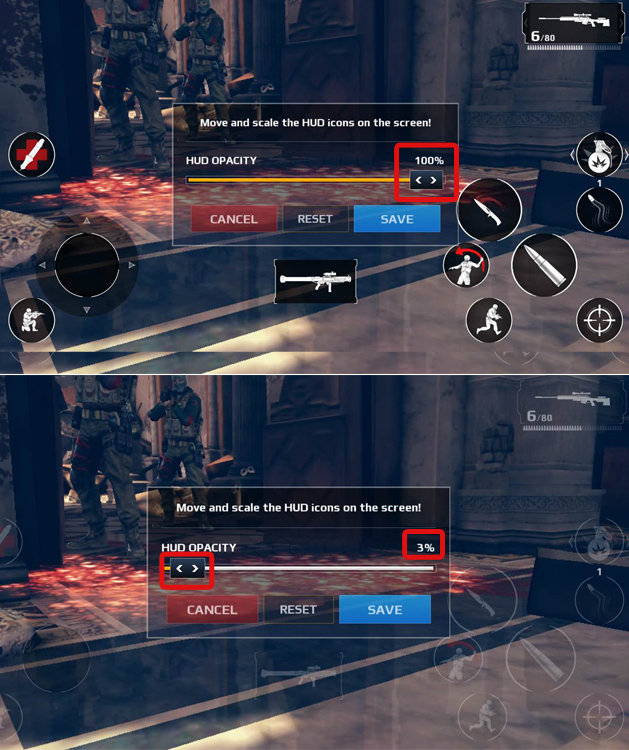
Players can customize the HUD interface opacity from 100% up to 0%, which allows them to free up the occupied HUD space and focus on the behavior of their enemies by choosing a level of transparency that is convenient for them.
But to fully understand how far the ability to customize the MC-5 has gone, you can only see the editor created by the developers, allowing you to ZOOM, MOVE AND CHANGE the layout of any existing HUD elements.

This image shows the standard size and position of the control circuit.
In the edit mode on the pause screen (below), you can see that players can shuffle, scale, and move items as they like.
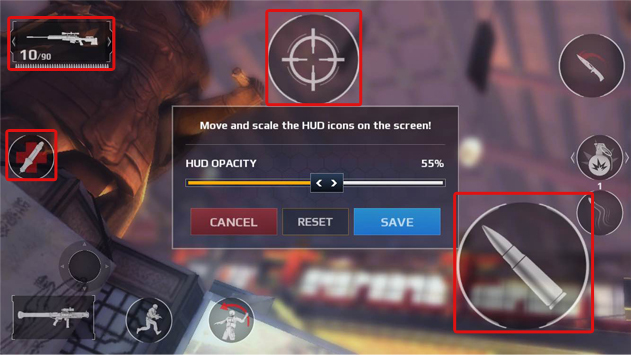
This level of customization provides a high degree of convenience for the game and personalized adjustment for the most fanatical players.
As you know, games for computers and consoles traditionally have a huge number of control options and settings.
But in mobile games that have their limitations, this can be a more extensive (and time-consuming development) degree of customization than any game provides today!
But will it be clever to transfer the task of setting up controls on mobile devices to players?
You can ask the question: why not just test and choose a standardized scheme, and not provide players with such a high degree of changes and combinations? The reason is as follows: in FPS games, different modes (campaign, multiplayer game, tournaments) and card types can change the behavior of players, so it is better to influence the adaptation to control with different settings, rather than just use the basic scheme.
Here are the real reviews found on the community forum of players, where veterans of the game recommend beginners to use different control settings for different game modes:
ALCATRAZ, veteran MC-5:
“In multiplayer mode, accuracy is as important as the speed of reaction, the correct aiming sensitivity is the key to victory. But automatic aiming and shooting are disabled in multiplayer mode.
... Fortunately, the MC-5 control settings allow you to adjust the sensitivity of the gyroscope , screen and aiming to suit your needs! ”
KILLSPREE, team leader:
“The game map is much smaller than in traditional FPS ; this means that a fixed target is easy prey, avoid standing still, move as much as possible!
To increase your speed, go to the control settings and turn on the auto-run option , which will allow you to move faster. ”
HELLRAISER, veteran MC-5:
“To be as fast as possible, it is better to place the most frequently used buttons as close as possible to the thumbs . Carefully customize your control offline to find the best button configuration for you. ”
It seems that GL has realized that no standard control scheme is suitable for all players in a game trying to recreate pure hardcore FPS gameplay without the advantages of standard game controllers and with the limitations of mobile devices.
So multiple iterations of the Modern Combat series of games led to what I call the “realistic” approach , in which players are provided with a wide range of tools to customize to their comfort zone.
MC-5 is considered one of the most popular FPS-games for mobile devices (a quick search on google confirms this).
The “realistic” approach reminds us that the target audience of the game is hardcore players who spend long hours learning skills in new game worlds, so for them this approach is natural.
... However, for casual and mid-core players, this is a very steep climb along the learning curve!
But as I said before, besides reducing LOADS through reducing values, which we have just considered, there is another approach to load management: ELIMINATION OF LOADS .
The developers understand that there are a lot of young players (who are now about 30 years old) playing with enthusiasm on computers and consoles in such FPS-game franchises like COD, TF2, GOW and DOOM. But working adults, parents or middle-aged people do not have enough time, concentration and dedication necessary to master the learning curve of hardcore players. In this case, the priorities are different!
METT, 34 years old, married, works as a sales representative:
“Studying in college, I often played in multiplayer campaigns with friends and created mods and maps for COD and DOOM. Now the hectic pace of work and the need to spend time with the family do not leave so many free minutes; I need the game to be easy to understand , the rounds should be short and the game should have simple controls . ”
GREGOR, 38 years old, IT-manager with two children:
“I need a game that you can play to relax in short breaks in work; game, replacing work during the break or in the toilet. My mobile phone is always with me ; I need an exciting gaming experience that doesn't require much effort . ”
In the past, they were ardent fans of the genre, and they lack the adrenaline and tension provided by such games.
It’s just a matter of finding a free niche in the market and providing such a user base with a way to meet its needs. And then the deer hunter franchise Glu Mobiles and Killshot Hothead studios come on the scene.
Both games simplify the basic cycle of searching and destroying targets, giving players the opportunity to play at their own pace; The loads in these games are significantly reduced and limited, which makes them fairly simple for beginners and players like Matt and Gregor.
The Deer Hunter series has become a big and successful Glu mobile franchise; Deer Hunter 2014 is one of the most successful flagship brands.
The Deer Hunter genre is simple, it is adapted from a famous computer series in which players hunt animals in exotic places around the world. For some (including me) the concept of hunting for wild animals may seem cruel, but for fans of hunting for game it is good fun (and it is definitely better than real hunting!). Deer Hunter uses high-quality graphics, which looks convincing and at the same time does not contain unnecessarily cruel details.

The basic gameplay of Deer Hunter is actually an FPS based on energy mechanics with mandatory improvements. The cycle of the basic process: hunting - rewards - improvements - unlocking
However, if we compare this game with the requirements defined by us above for standard FPS games, we will see that the DH series completely eliminates many of the requirements from the gameplay.

Green - the load exists, red - the load is eliminated, yellow - the load is minimized
Looking at the table, we understand how much less loads in the DH series compared to the MC-5; this turned out to be a game that, although not intended for hardcore players, but significantly smoothes the steep learning curve and the skill curve. However, in the short time spent in the game, it provides the adrenaline rush required for casual and adult players.

HUD MC-5 versus DH Comparison
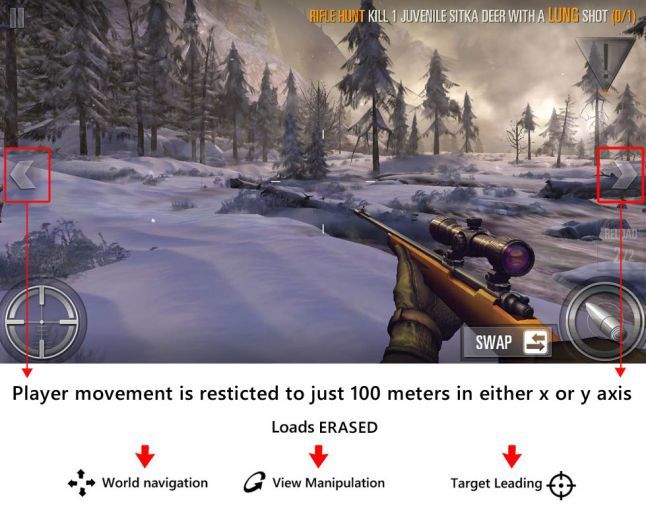
Player movement is limited to a hundred meters along the x and y axes. Resolved loads: moving around the world, camera control, target tracking
At a glance you can see the difference in the management of the HUD of these two games. HUD DH contains only the left optical sight button and the right shooting button, as well as the arrows to move left-right or forward-backward, depending on the level structure.
This type of HUD control has grown out of the fact that the elimination of loads (as in the case of DH-16) directly leads to a decrease in the amount of control, due to which the player is left to manage fewer loads.
As we have seen from Matt and Gregor ’s examples, it’s all a matter of shifting priorities. Games must adapt to the lifestyle of maturing players.
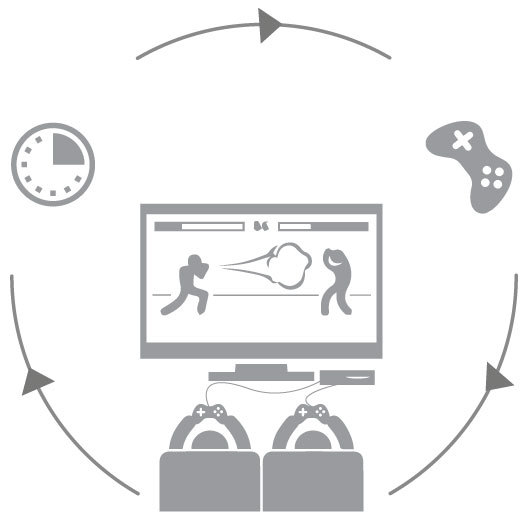
When Matt and Gregor were teenagers, and then twenty years old, they could devote enough TIME to games.

But now, in conditions of intense pace of life, they must enter the GAMES in their time and schedule!
This lifestyle change has made mobile devices preferable for games due to the constant proximity to this segment of maturing players, regardless of the situation, be it a break in work, waiting for the train in the subway or a short visit to the toilet. There is always time to get a quick charge of FPS without spending time on the menu and settings.
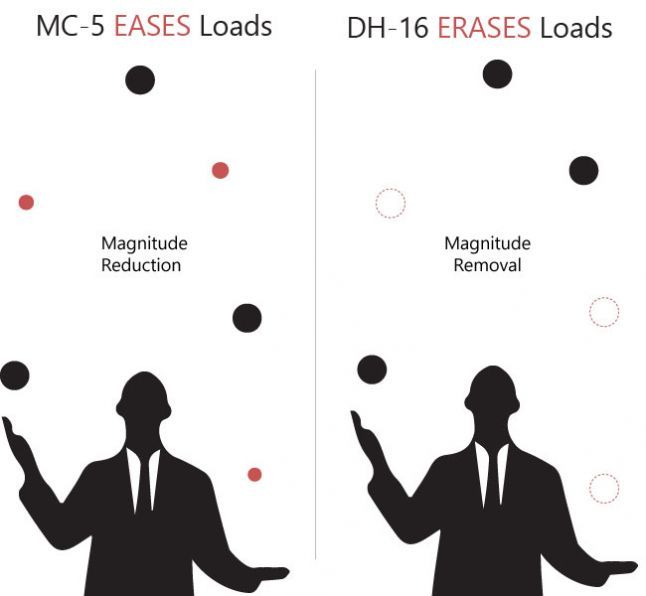
MC-5 reduces load / DH-16 eliminates load
However, the loads are not eliminated only in the area of basic gameplay; load reduction is also reflected in the UI style of the two games.

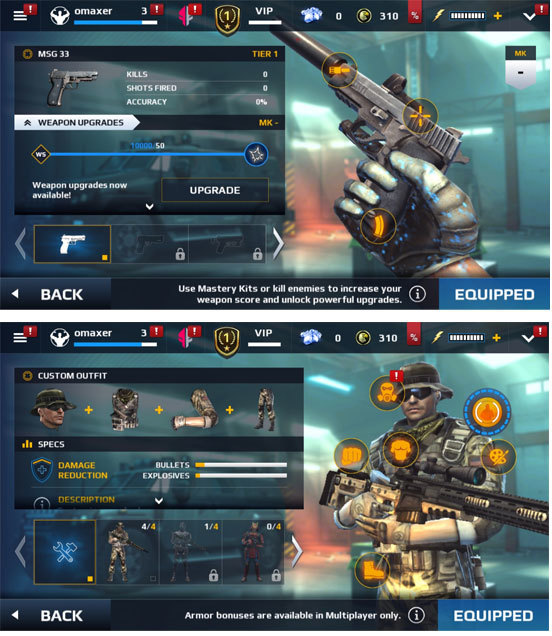
In games like the MC-5, there are often sophisticated selection menus with a variety of gadgets, ammunition, armor, primary and secondary weapons that a player can equip in front of a mission
Above are just a few screens from the huge inventory base available for players to choose in MC-5 before the mission. They have to make just a bunch of decisions! (This also implies that the player must learn what each choice means and remember them, because all the options have their advantages.)
All these choices will delight purists, but for adult players every minute of free time is important. They want to quickly get into the game, not wander in the maze of options and decision-making!
In the DH series, the developers adapted the UX / UI screens so that the player could move to the main gameplay as quickly as possible, and the game was not complicated by the agony of choice.
Although there is a large inventory in the DH series (the content is necessary for the game to be played for a long time!), It does not shift the burden of responsibility for making decisions and for the consequences of choosing the player.
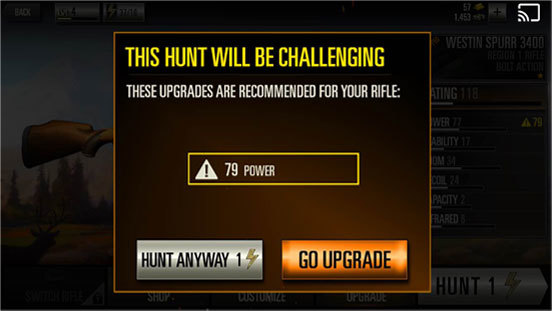
“The hunt will be difficult. There are recommended improvements for your rifle. ”
At the required intervals in front of the player there are notifications with recommendations to improve the weapon.
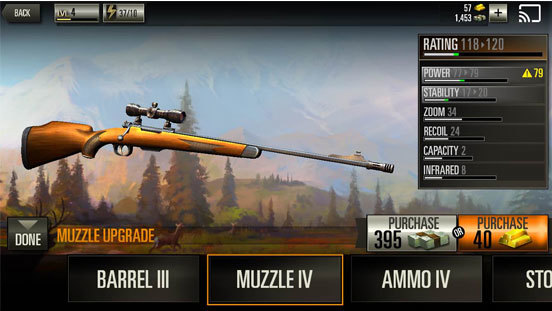
By clicking on the improvement button, the player immediately proceeds to the best option without searching for inventory and mental strain.
Another way to improve equipment is applied directly in the main game process, where the player can choose to purchase or use acquired improvements on the game screen itself without having to equip objects outside the game process cycle. This speeds up the process and ensures that several minutes are enough for a full game session.
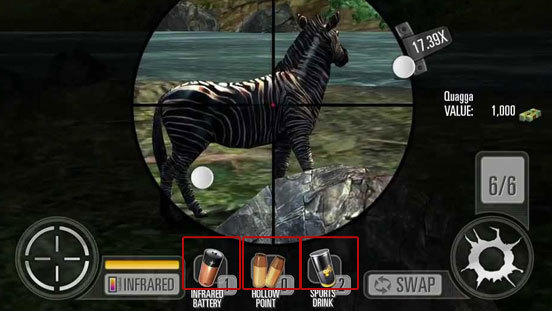
This algorithm ensures that the player does not spend a lot of time moving from screen to screen. All he needs is to enter the game and immediately go to the gameplay screen; the game will automatically adjust the choice of upgrades and equipment improvements, informing the player about it.
Using the example of the MC-5 and DH-16 series, we see how the FPS games aimed at different player segments (hardcore / adult and casual players) adapt to different market segments.
It is interesting to observe how, using various approaches to reducing and eliminating loads, developers can significantly change the gameplay sensations created for players based on their expectations and market segments, successfully recreating one of the most popular genres on mobile devices, traditionally considered to belong only to computers and consoles.
The search for the true spirit of FPS with a more intuitive and enjoyable gameplay for purists continues.
Why is re-creating the true spirit of FPS on mobile so painful?
Traditionally, FPS games required players to be highly skilled, accurate, fast, focused and skillful. That is what made the sensations of playing on the learning curve so pleasant (or annoying, depending on how much the player mastered it).
Before learning how to recreate the gameplay of computer or console FPS on mobile devices, let's consider what kind of load usually affects the player.
Loads and noise, usually affecting the player in FPS games on computers and consoles
For a casual observer, FPS may look like indiscriminate and meaningless shooting:
')

But do not be deceived; in fact, a FPS player juggles with a multitude of cognitive loads of various sizes, coordinates motor and sensory skills, and fights against the interference created by control devices in order to achieve his goal.
Does this statement seem surprising to you?

As a juggler who balances several loads, usually while playing FPS, the player must balance the following cognitive loads :

Target Capture: A player must effectively capture moving or static targets in order to accomplish a kill.
Keeping the goal: the player must effectively “lead” the goal. For example, if the opponent moves to the right of the player, then the player must create his mental copy for a successful hit.
Goal tracking: you need to track moving targets so that you do not need to constantly retake them. For example, if the enemy moves to the right, the player must constantly smoothly follow the enemy, without losing sight of him.
Camera control: the player moves the camera in the right directions for tracking, tracking and capturing targets. The difference in the speed with which a player can control the field of view affects the ability to track and drive fast moving targets.
Moving around the world: the player must be able to move along the X, Y and Z axes of the game world in order to overcome obstacles or jump onto objects.
UI control: along with the above tasks, the player is required to control the UI control for equipment, applying character abilities, turning on sight, using boosts, shooting control, reloading and changing weapons.
Game controllers transmit these tasks to the UI, which reduces the load by providing a better display. But this does not apply to the standard gameplay on mobile devices.
Interesting study
Because of the above loads, the learning curve for mastering FPS is very steep; sensory interaction and lack of usable space on mobile devices make it even worse.
Fitts Act:

This scientific law predicts that the time required for a quick move to the target area is a function of the ratio of the distance to the target and the width of the target.
The farther the target is and the smaller its size, the more difficult it is for the user to “catch” this target.
This implies that the smaller the moving target, the more difficult it is for players in FPS to aim and shoot at it. Studies conducted in a controlled environment have shown that mouse pointers are more accurate in capturing long-range small targets:
Comparison of the aiming area of a finger and mouse.

The middle area that can be selected with the mouse and finger:

The images above show the pixel-by-pixel movement (pixel-perfect control) of the mouse pointer, resulting in a smaller aiming area as compared to a less accurate (minimum 40 pixels) aiming area with your finger.

Finger overlapping the aiming area is also a well-known problem.
Error rate measurements for various input devices:

Give up, the mouse pointers won in accuracy and capture of small and distant targets, mainly due to the ability to quickly jump to the right pixel on the screen.
So, on mobile devices, the lack of usable space and touch input has become a real problem. Add to this the various loads and movements (discussed above) that a player must manage in hardcore FPS and lack of accuracy of the input device (finger), which makes adaptation even more difficult.
However, the question is how to solve these problems, being a developer of mobile games?
Let's find out:

The main thing is load management!

Reduced loads: reduced values; removal of loads: getting rid of quantities
Many successful mobile FPS-games tried to adapt the gameplay, concentrating on facilitating load management , reducing them by reducing the values or eliminating them, completely getting rid of them. Below I will provide examples of such solutions.
Load reduction
Modern Combat 5 - "realistic" approach
Despite the difficulties listed above, some game developers have tried to recreate the key FPS gameplay on mobile devices; The most notable and successful of these was the Gameloft series Modern Combat.
- Level of difficulty: hardcore and medium
- Target audience: hardcore FPS players who have previously played COD, Destiny, Bioshock

The Modern Combat series has become the most popular among FPS players on mobile devices. The latest version of MC-5 (an MC-6 release is expected soon) has become evidence of a multitude of iterations performed by GL to fine-tune how users perceive the game.
At first, the MC-5 provides players with standard control options, but soon there is ample room for flexible, personalized settings.
Pre-mission setting option
Before launching a mission on the settings screen, players in the MC-5 can choose one of three different control options:

Below are three standard control schemes with 13 parameters , with a wide range of configuration options. They significantly reduce the magnitude of the various loads on the player:

The following explains how these options reduce the magnitude of the various loads described above.

Settings for screen sensitivity, gyroscope sensitivity and aiming sensitivity reduce camera control loads, target acquisition and movement around the world
The lack of accuracy caused by the lack of a mouse on a small screen is compensated by adjusting the sensitivity of the sensor and the built-in gyroscope, which helps the player to use the device as a controller.

Assistance in aiming, automatic shooting and squatting (these settings are included only in a single game) reduce the load of controlling the camera, tracking a target, capturing a target and moving around the world
Assistance in aiming and automatic shooting reduces the difficulty of tracking and capturing targets, allowing the player to focus on other game loads and reducing dependence on UI controls; The same is true for automatic squats.

Automatic running, camera re-centering and smooth camera movement reduce camera control loads, movement around the world and target tracking
One of the most powerful pain points on mobile devices is the small size of the map due to the very nature of the scene and the limited view of the camera; This leads to the fact that the player can fall victim to the enemies who track him, especially on multiplayer maps; The above settings significantly reduce the load.

Aiming with a gyroscope, the ability to invert the vertical axis and turn off pop-up notifications reduce the load of tracking the target, leading the target and controlling the camera
Three standard control schemes with 13 settings. If you think it is a little too, hold on - there are others. So far we have considered only the control settings before the mission, but in the MC-5 there are other settings options that can be changed during the mission on the pause screen .

This second level of highly detailed HUD setup is only available on the pause screen during game play.

Players can customize the HUD interface opacity from 100% up to 0%, which allows them to free up the occupied HUD space and focus on the behavior of their enemies by choosing a level of transparency that is convenient for them.
But to fully understand how far the ability to customize the MC-5 has gone, you can only see the editor created by the developers, allowing you to ZOOM, MOVE AND CHANGE the layout of any existing HUD elements.

This image shows the standard size and position of the control circuit.
In the edit mode on the pause screen (below), you can see that players can shuffle, scale, and move items as they like.

This level of customization provides a high degree of convenience for the game and personalized adjustment for the most fanatical players.
As you know, games for computers and consoles traditionally have a huge number of control options and settings.
But in mobile games that have their limitations, this can be a more extensive (and time-consuming development) degree of customization than any game provides today!
But will it be clever to transfer the task of setting up controls on mobile devices to players?
You can ask the question: why not just test and choose a standardized scheme, and not provide players with such a high degree of changes and combinations? The reason is as follows: in FPS games, different modes (campaign, multiplayer game, tournaments) and card types can change the behavior of players, so it is better to influence the adaptation to control with different settings, rather than just use the basic scheme.
Real testers are players.
Here are the real reviews found on the community forum of players, where veterans of the game recommend beginners to use different control settings for different game modes:
ALCATRAZ, veteran MC-5:
“In multiplayer mode, accuracy is as important as the speed of reaction, the correct aiming sensitivity is the key to victory. But automatic aiming and shooting are disabled in multiplayer mode.
... Fortunately, the MC-5 control settings allow you to adjust the sensitivity of the gyroscope , screen and aiming to suit your needs! ”
KILLSPREE, team leader:
“The game map is much smaller than in traditional FPS ; this means that a fixed target is easy prey, avoid standing still, move as much as possible!
To increase your speed, go to the control settings and turn on the auto-run option , which will allow you to move faster. ”
HELLRAISER, veteran MC-5:
“To be as fast as possible, it is better to place the most frequently used buttons as close as possible to the thumbs . Carefully customize your control offline to find the best button configuration for you. ”
It seems that GL has realized that no standard control scheme is suitable for all players in a game trying to recreate pure hardcore FPS gameplay without the advantages of standard game controllers and with the limitations of mobile devices.
So multiple iterations of the Modern Combat series of games led to what I call the “realistic” approach , in which players are provided with a wide range of tools to customize to their comfort zone.
Did he work?
MC-5 is considered one of the most popular FPS-games for mobile devices (a quick search on google confirms this).
The “realistic” approach reminds us that the target audience of the game is hardcore players who spend long hours learning skills in new game worlds, so for them this approach is natural.
... However, for casual and mid-core players, this is a very steep climb along the learning curve!
But as I said before, besides reducing LOADS through reducing values, which we have just considered, there is another approach to load management: ELIMINATION OF LOADS .
The developers understand that there are a lot of young players (who are now about 30 years old) playing with enthusiasm on computers and consoles in such FPS-game franchises like COD, TF2, GOW and DOOM. But working adults, parents or middle-aged people do not have enough time, concentration and dedication necessary to master the learning curve of hardcore players. In this case, the priorities are different!
METT, 34 years old, married, works as a sales representative:
“Studying in college, I often played in multiplayer campaigns with friends and created mods and maps for COD and DOOM. Now the hectic pace of work and the need to spend time with the family do not leave so many free minutes; I need the game to be easy to understand , the rounds should be short and the game should have simple controls . ”
GREGOR, 38 years old, IT-manager with two children:
“I need a game that you can play to relax in short breaks in work; game, replacing work during the break or in the toilet. My mobile phone is always with me ; I need an exciting gaming experience that doesn't require much effort . ”
In the past, they were ardent fans of the genre, and they lack the adrenaline and tension provided by such games.
It’s just a matter of finding a free niche in the market and providing such a user base with a way to meet its needs. And then the deer hunter franchise Glu Mobiles and Killshot Hothead studios come on the scene.
Both games simplify the basic cycle of searching and destroying targets, giving players the opportunity to play at their own pace; The loads in these games are significantly reduced and limited, which makes them fairly simple for beginners and players like Matt and Gregor.
Deer Hunter 2016: CSR Racing with guns?
The Deer Hunter series has become a big and successful Glu mobile franchise; Deer Hunter 2014 is one of the most successful flagship brands.
The Deer Hunter genre is simple, it is adapted from a famous computer series in which players hunt animals in exotic places around the world. For some (including me) the concept of hunting for wild animals may seem cruel, but for fans of hunting for game it is good fun (and it is definitely better than real hunting!). Deer Hunter uses high-quality graphics, which looks convincing and at the same time does not contain unnecessarily cruel details.

The basic gameplay of Deer Hunter is actually an FPS based on energy mechanics with mandatory improvements. The cycle of the basic process: hunting - rewards - improvements - unlocking
However, if we compare this game with the requirements defined by us above for standard FPS games, we will see that the DH series completely eliminates many of the requirements from the gameplay.
Comparison of FPS loads in DH and MC-5

Green - the load exists, red - the load is eliminated, yellow - the load is minimized
Looking at the table, we understand how much less loads in the DH series compared to the MC-5; this turned out to be a game that, although not intended for hardcore players, but significantly smoothes the steep learning curve and the skill curve. However, in the short time spent in the game, it provides the adrenaline rush required for casual and adult players.

HUD MC-5 versus DH Comparison

Player movement is limited to a hundred meters along the x and y axes. Resolved loads: moving around the world, camera control, target tracking
At a glance you can see the difference in the management of the HUD of these two games. HUD DH contains only the left optical sight button and the right shooting button, as well as the arrows to move left-right or forward-backward, depending on the level structure.
This type of HUD control has grown out of the fact that the elimination of loads (as in the case of DH-16) directly leads to a decrease in the amount of control, due to which the player is left to manage fewer loads.
As we have seen from Matt and Gregor ’s examples, it’s all a matter of shifting priorities. Games must adapt to the lifestyle of maturing players.

When Matt and Gregor were teenagers, and then twenty years old, they could devote enough TIME to games.

But now, in conditions of intense pace of life, they must enter the GAMES in their time and schedule!
This lifestyle change has made mobile devices preferable for games due to the constant proximity to this segment of maturing players, regardless of the situation, be it a break in work, waiting for the train in the subway or a short visit to the toilet. There is always time to get a quick charge of FPS without spending time on the menu and settings.

MC-5 reduces load / DH-16 eliminates load
However, the loads are not eliminated only in the area of basic gameplay; load reduction is also reflected in the UI style of the two games.


In games like the MC-5, there are often sophisticated selection menus with a variety of gadgets, ammunition, armor, primary and secondary weapons that a player can equip in front of a mission
Above are just a few screens from the huge inventory base available for players to choose in MC-5 before the mission. They have to make just a bunch of decisions! (This also implies that the player must learn what each choice means and remember them, because all the options have their advantages.)
All these choices will delight purists, but for adult players every minute of free time is important. They want to quickly get into the game, not wander in the maze of options and decision-making!
In the DH series, the developers adapted the UX / UI screens so that the player could move to the main gameplay as quickly as possible, and the game was not complicated by the agony of choice.
But how? Automation of choice
Although there is a large inventory in the DH series (the content is necessary for the game to be played for a long time!), It does not shift the burden of responsibility for making decisions and for the consequences of choosing the player.

“The hunt will be difficult. There are recommended improvements for your rifle. ”
At the required intervals in front of the player there are notifications with recommendations to improve the weapon.

By clicking on the improvement button, the player immediately proceeds to the best option without searching for inventory and mental strain.
Another way to improve equipment is applied directly in the main game process, where the player can choose to purchase or use acquired improvements on the game screen itself without having to equip objects outside the game process cycle. This speeds up the process and ensures that several minutes are enough for a full game session.

This algorithm ensures that the player does not spend a lot of time moving from screen to screen. All he needs is to enter the game and immediately go to the gameplay screen; the game will automatically adjust the choice of upgrades and equipment improvements, informing the player about it.
Conclusion
Using the example of the MC-5 and DH-16 series, we see how the FPS games aimed at different player segments (hardcore / adult and casual players) adapt to different market segments.
It is interesting to observe how, using various approaches to reducing and eliminating loads, developers can significantly change the gameplay sensations created for players based on their expectations and market segments, successfully recreating one of the most popular genres on mobile devices, traditionally considered to belong only to computers and consoles.
The search for the true spirit of FPS with a more intuitive and enjoyable gameplay for purists continues.
Source: https://habr.com/ru/post/310224/
All Articles